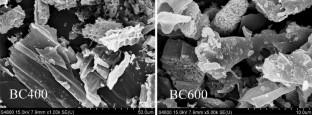Bulletin of Environmental Contamination and Toxicology ( IF 2.7 ) Pub Date : 2022-06-03 , DOI: 10.1007/s00128-022-03538-y Xiaobing Wang 1, 2 , Shuai Ma 1 , Xiaoli Wang 1 , Tong Cheng 1 , Junneng Dong 1 , Ke Feng 1, 2

|
Copper (Cu) pollution in soils has received considerable research attention globally, and biochar has been widely used as an adsorbent for soil pollution of Cu. However, most of the studies focused on the adsorption capacity of biochar, the bioavailability of Cu absorbed by biochar remains unclear. In this work, rice straw biomass was pyrolyzed under oxygen-limited conditions at 400°C (BC400) and 600°C (BC600), their apparent structure, group characteristics, and basic physical and chemical properties were determined. The isothermal and kinetics adsorption of Cu by BC400 and BC600 were analyzed. A pot experiment was used to evaluate the passivation of Cu in the soil by biochar and the bioavailability of Cu adsorbed by biochar in the soil. The smooth surfaces of BC400 evolved into more rough surfaces for BC600, and both types of surfaces may give active sorption sites for Cu, according to SEM pictures. FTIR analysis suggested that BC600 is endowed with more condensed aromatic carbon structures and more available polar functional groups. The adsorption processes of Cu2+ by biochar were better fitted Langmuir equation and pseudo-second-order kinetic model. The adsorption isotherms showed monolayer adsorption of Cu2+ on biochar. The maximum adsorption capacities of BC600 and BC400 on Cu2+ were 43.75 and 30.70 mg g−1, respectively. Moreover, the pot experiment showed that BC400 and BC600 not only have a strong “passivation” effect on Cu in soil but also prevent the release of adsorbed Cu. Overall, more aromatic carbon structure, more polar functional groups, and higher pH are associated with BC600’s increased Cu immobilization ability in soil.
中文翻译:

稻草生物炭吸附Cu2+的机理及其对土壤中Cu2+的吸附-解吸能力
土壤中的铜(Cu)污染在全球范围内受到了相当多的研究关注,生物炭已被广泛用作土壤铜污染的吸附剂。然而,大多数研究都集中在生物炭的吸附能力上,生物炭对Cu的生物利用度尚不清楚。在这项工作中,稻草生物质在 400°C(BC400)和 600°C(BC600)的限氧条件下热解,测定了它们的表观结构、组特征和基本理化性质。分析了BC400和BC600对Cu的等温吸附和动力学吸附。采用盆栽试验评价了生物炭对土壤中Cu的钝化作用以及生物炭吸附土壤中Cu的生物有效性。BC400 的光滑表面演变成 BC600 更粗糙的表面,根据 SEM 图片,两种类型的表面都可能为 Cu 提供活性吸附位点。FTIR 分析表明,BC600 具有更多的稠合芳族碳结构和更多可用的极性官能团。Cu的吸附过程biochar 2+较好地拟合了Langmuir方程和准二级动力学模型。吸附等温线显示Cu 2+在生物炭上的单层吸附。BC600和BC400对Cu 2+的最大吸附量分别为43.75和30.70 mg g -1。此外,盆栽实验表明,BC400和BC600不仅对土壤中的Cu有很强的“钝化”作用,而且还能阻止吸附的Cu释放。总体而言,更多的芳香碳结构、更多的极性官能团和更高的 pH 值与 BC600 在土壤中增加的铜固定能力有关。











































 京公网安备 11010802027423号
京公网安备 11010802027423号